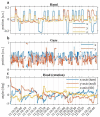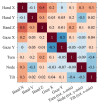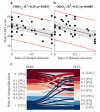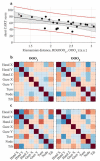Assessment of cognitive biases in Augmented Reality: Beyond eye tracking
- PMID: 37179771
- PMCID: PMC10171922
- DOI: 10.16910/jemr.15.3.4
Assessment of cognitive biases in Augmented Reality: Beyond eye tracking
Abstract
We study an individual's propensity for rational thinking; the avoidance of cognitive biases (unconscious errors generated by our mental simplification methods) using a novel augmented reality (AR) platform. Specifically, we developed an odd-one-out (OOO) game-like task in AR designed to try to induce and assess confirmatory biases. Forty students completed the AR task in the laboratory, and the short form of the comprehensive assessment of rational thinking (CART) online via the Qualtrics platform. We demonstrate that behavioural markers (based on eye, hand and head movements) can be associated (linear regression) with the short CART score - more rational thinkers have slower head and hand movements and faster gaze movements in the second more ambiguous round of the OOO task. Furthermore, short CART scores can be associated with the change in behaviour between two rounds of the OOO task (one less and one more ambiguous) - hand-eye-head coordination patterns of the more rational thinkers are more consistent in the two rounds. Overall, we demonstrate the benefits of augmenting eye-tracking recordings with additional data modalities when trying to understand complicated behaviours.
Keywords: Eye movement; augmented reality; cognitive bias; correlation matrix; earth mover’s distance; eye tracking; hand movement; head movement.
Conflict of interest statement
The author(s) declare(s) that the contents of the article are in agreement with the ethics described in http://biblio.unibe.ch/portale/elibrary/BOP/jemr/ethics.html and that there is no conflict of interest regarding the publication of this paper.
Figures








References
-
- Araújo, D., Davids, K., & Hristovski, R. (2006). The eco-logical dynamics of decision making in sport. Psychology of Sport and Exercise, 7(6), 653–676. 10.1016/j.psychsport.2006.07.002 - DOI
-
- Beltrán, J., García-Vázquez, M. S., Benois-Pineau, J., Gutierrez-Robledo, L. M., & Dartigues, J.-F. (2018). Computational techniques for eye movements analysis towards supporting early diagnosis of Alzheimer’s disease: A review. Computational and Mathematical Methods in Medicine, 2018, 2676409. Advance online publication. 10.1155/2018/2676409 - DOI - PMC - PubMed
LinkOut - more resources
Full Text Sources
Research Materials
